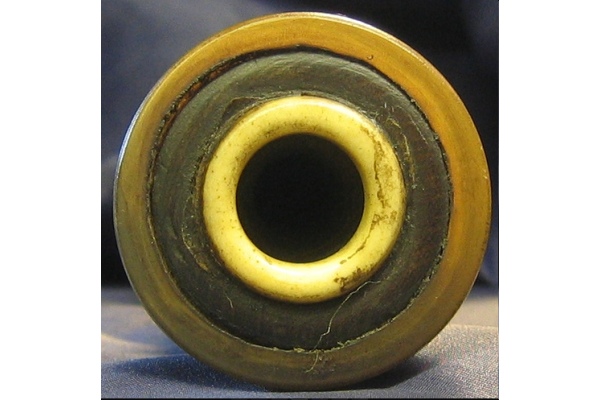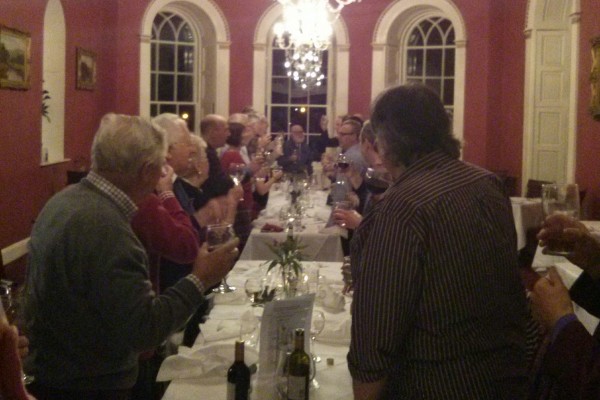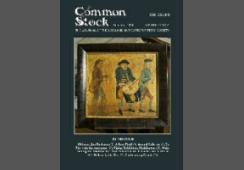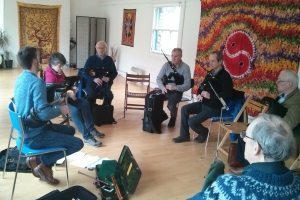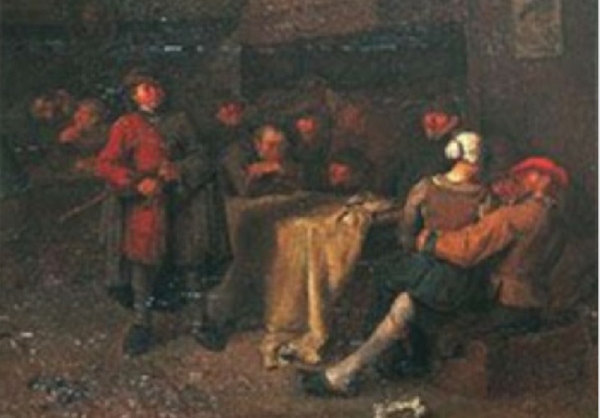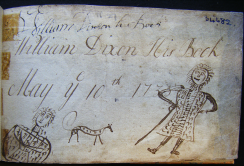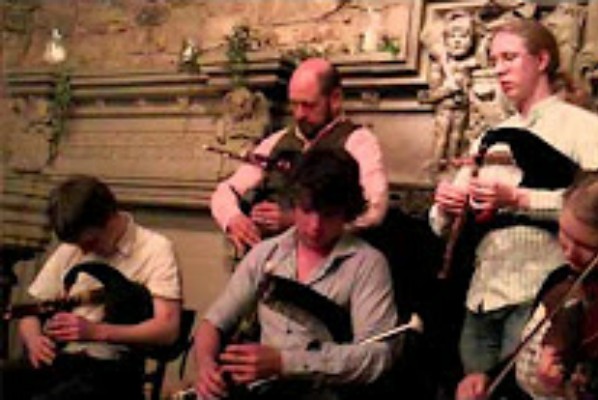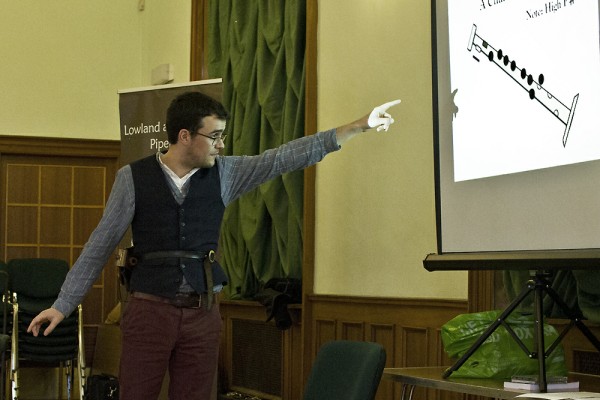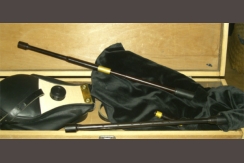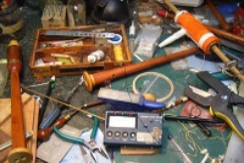Transcriptions of the short presentations given by the six pipemakers at this year’s conference
Julian Goodacre’s Introduction:
‘Welcome everybody; this is the pipemakers’ forum; we’ve never done this before in this format; the initial idea was for each of us to give a five minute talk then afterwards throw it open so that you can ask each of us any questions arising. We don’t know what each of us is going to talk about So we have Richard Evans, Donald Lyndsay Nigel Richard, Ross Calderwood and Burgess Hay, each allotted six minutes'

Julian Goodacre’s presentation
‘My talk was going to be called ‘Some of the challenges in making faithful copies of old conical chanters, but I decided to change that to Coping with Some of the challenges in ...So let’s talk about the basic design elements of the chanter; you have an inner cone - it can be different angle - you then have the outside profile - you’ve got finger holes, and you’ve got a reed. Now all those can be variable, the possibilities are infinite. You can start out of thin air designing a chanter - I’ve done that many times. You have to commit to your initial bore; you then make an outside profile. And then you’re left with a dance and shuffle between the reed and the finger holes. this chanter here has got about 60 holes, most of which have been blocked up, because you get the thing playing nicely, you alter the reed design and then the finger holes are wrong - you shift things around - and ultimately you end up, hopefully, with a design that works. (Julian plays a scale on one of his English chanters) But always when you’re making a bagpipe, it could be a little bit better, but I had complete freedom making that; I could do anything I wanted.
The next style of making is to go to an early, an old instrument - well, it doesn’t have to be old - and copy it in great detail. I the early 1990’s I went to the Scottish Museum and measured a border chanter. I was very naive; to start with I pushed a series of little plastic discs up the bore and measured those. I then worked out my reamer and made a chanter with the same outside profile and the same finger-spacing and it wouldn’t play in A and I wanted it to play in A so i imposed my will on that one, which had been played for over a hundred years perfectly by someone, but we don’t know what pitch it was in. So I extended the bore and then started shuffling the finger holes until I got a nice playing chanter. So this chanter is ‘historically informed’ but it’s not an accurate copy. Now the fun starts when you decide to make an absolutely accurate copy.
In the 1990’s Barnaby Brown approached me to see if we could make a copy of the Iain Dall chanter which at that stage was in Nova Scotia; it is currently resting in the national Piping Centre. It’s in a terrible state; it was played by Iain Dall Mackay, owned by him - he was one of the early writers and performers of pibroch - so we’re talking about something that is 300 or 350 years old. I reckon it is Scotland’s most precious piping relic. Barnaby wanted me to copy it in as great detail as possible, so we went over to Halifax, Nova Scotia.
It’s in terrible condition - it’s snapped and the finger holes are very worn. We had two days measuring it; by this time my measuring techniques were better - I had a series of ovals, and we put an oval up the chanter and found the maximum measurement and then the minimum.
Now, when I started measuring pipes I thought the chanter may have distorted a bit and I thought it was just like a plastic tube and would go oval, but it doesn’t, it goes egg-shaped. I used to think, take the maximum and minimum and divide by two and bingo, you’ve got the original measurement. You haven’t (and also wood shrinks the other way too) but there is a formula that we are now working on that takes into account these deficiencies of measurement, so we’ve been using that. I’ve been working for years on making copies of this chanter; Scottish pipemakers couldn’t really deal with the changes to the reed staple, but it works and Barnaby has been playing it and recorded with it.
We’re now working with a bassoon reed maker over in Canada who is creating a completely different style of reed, and he wants more information about the top of the bore; we haven’t measured it in great enough detail for him so now we have to go back, re-measure it and see whether the new reed will further the development.
Patrick Mollard, when he first heard of what we were doing said we were involved in a life-time’s adventure. At the time we kind of laughed but now, ten years later I realise that yes, it is a lifetime’s adventure.’
Ross Calderwood’s presentation

‘It was a few years ago - are there any members of the Bagpipe Society here? (Grunts of ‘aye’ from some sectors of the room) - a few years ago there was an article in Chanter (the journal of the bagpipe Society) about the Rostock chanter. The Rostock chanter is the oldest smallpipe chanter - the oldest bagpipe chanter- we’ve got. Miles older than the Iain Dall chanter - (laughter). We can accurately date it, since it was found in a midden, to 1480. I didn’t even bother copying it, because if you look at the drawings, the hole positions - you’re not going get a scale that’s actually going to work in a modern setting. But there are a few things that you can take and the main thing i was interested in Was the bore-size. It was over 6mm. Even taking into account, as Julian mentioned, you have to do, the amount of shrinkage and such like, it was definitely a wide bore, which leads you on to thinking it wasn’t a double reed, it was a single reed instrument. Rostock, where the chanter was found, is on the Baltic, Northern Germany. The next thing I was looking at, which got me thinking, was playing Swedish music and the Swedish bagpipe, the sackpipa. They use a bore very similar. They have a revival, not quite dead but a revival similar to us, which came to the making of a new instrument, but basically the same sort of bore.
So the next thing I’ve got to look at is reeds, I tried various other reeds but i thought I’d go down the plastic route and try and get something a bit more stable. So I tried various different forms of plastic. I was speaking to Sean [Jones] who’s been working with the same thing; I’ve tried carbon fibre, styrene, various things as well as different bore sizes for the reed. I even tried with some eazydrones but I just could not get them working. In the end I had to use the original Swedish reed which, for highland pipers, is more or less the old drone reed. So I started with this and the bore and just began chopping and changing. The other thing i wanted to do was to get it to play in D mixolydian because it’s what I know. But I’ve added a few things, I’ve got a back bottom hand thumbhole so that i can play in d minor and I’ve got a little rubber insert I use which helps us to get the minor 6th so that I can play in G minor as well.
The next thing is in developing reeds, which is something we all go through in trying to recreate things. At this stage , having based it on the bore and on the reed I ended up with something like Julian had (a chanter with many blocked off holes ) This one’s mark two and this one’s mark three
The other thing you look at is the period, historic information for the aesthetics, so I was looking at various etchings, plus the original Rostock chanter, though I’ve added the octave thumbhole and I’ve had to shift things a bit, but it’s more or less like the original. The etchings were particularly useful in deigning the drone. Some of the 15th/16th century bagpipes don’t have drones, but I wanted a drone, and I wanted one the same as the chanter so when you hit the tonic it disappears. So the drone reed is the same as the chanter reed, so you get that sort of magic thing where once you get it in tune the chanter tonic disappear in the drone sound. The other thing is the bag. Bag resonance affects the tuning of the chanter, so that getting the right shape is important, and it’s usually a rounded shape.’
[Here the chairman called time: Ross' original article he mentions is HERE]
Burgess Hay’s presentation

‘Hello; I’m Burgess hay and as Julian said, the newest maker here. When we were thinking about what we were going to talk about today, we decided to tell you a bit about us and our approach and why we’re doing what we do. Obviously you don’t just wake up one morning and decide to be a bagpipe maker. Behind what we do are generations of history and experience which was funneled through Fiona’s [Burgess’s wife] father a guy called John McDougal who was a world champion piper, he was a multi-god medallist and a respected judge. And the number of times John and I would sit and be talking about this perfect chanter that we were going to make , well we’re still working our way towards that, but ours is a true family business, so we all work in the business ourselves. And as a family business it doesn’t always go smoothly but we try and work it out.
Our approach when we decided to make pipes professionally was to make the best possible instruments that we could. Each instrument has been designed from scratch and we use preset criteria for each. As an example we wanted our Scottish smallpipes to nice and mellow, quiet enough to be played indoors but still have a conversation over the top of them.
To start the process, we start off with a different approach. In designing the instruments we start with some basic maths and physics and then we generate a 3D computer model of the instrument, drones and chanter, and then that translates into a piece-part design. That gives us an idea of how it will perform and what it will look like before we even start cutting the wood.
We always start with the drones; we design the drones first and then we move on to the chanter. Each component. We look at each component individually looking at its form and its function and then when we put them all together we make tweak them to make it work as a complete unit.
We use what we consider the best possible material which is African Blackwood and titanium and we don’t use anything else. The wood we import from Africa ourselves. Titanium is a fantastic material - it’s strong, it never corrodes, will never tarnish and it’s used in lots of really high- spec applications. In aerospace, medical devices etc., so why not bagpipes. Until now we’ve used plain titanium ferrules and mounts but just in the next wee couple of months we’re going to start engraving them, a serial number or maybe the customer’s name.
We manufacture everything ourselves inhouse and to be able to process the titanium and the African Blackwood we use CNC technology, we don’t hide the fact, and we use standard industrial practices across all the pipes and all the products. We don’t use our CNC equipment to churn the instrument out we use the equipment to our advantage so basically it gives us consistency and accuracy across all the pieces, and of course, once you have consistency and accuracy you have a completely stable instrument.
We’re lucky that we’re starting to get orders from around the word; as an example we sent a set of smallpipes from us on a Wednesday afternoon, it arrive in Michigan USA on the Friday and the customer took it out of the box and it was still in tune and he posted that fact on Bob Dunsire’s website.
We have no issues with CITES with the African Blackwood; because we import the wood ourselves we know exactly where it comes from. We buy instrument grade wood; we don’t buy anything that hasn’t been stored for a minimum of five years.
So what do we make? We make Scottish smallpipes in A, D, and C as well as combination sets. We make Border pipes in the key of A with a chromatic chanter, we make standard highland bagpipes in Bflat and we also make true highland bagpipe in the key of A which also has a chromatic chanter. We’ve been going for two years professionally and we’ve learned a lot, we’ve met lots and lots of great people. We hope that the pleasure we get is reflected in the instruments we make.’
Nigel Richard’s presentation
‘What I’m going to talk about is more on the acoustic side because I’ve been around for longer than I deserve, so as far as my pipes are concerned people know about them and I’m happily still making pipes and getting plenty of orders and I’m actually trying to make less than i did before. - It’s just struck me that it’s just as well my mum’s not listening to that last sentence because she would have been horrified. Anyway, talking about acoustics; we’ve got three things that we’re interested in, resonance, harmonics and timbre, and this all feeds on into talking about scales. Resonance is the tendency of a system to oscillate at a greater amplitude at some frequencies than others, and these are known as the systems resonant frequencies. Now this may all sound very technical, but what actual bagpipe chanter design is about, and this refers particularly to the conical bore, what is happening is that there are a whole lot of very odd things happening in there and there are a whole lot of counter-intuitive things happening in there. It’s due to the fact that, as we all know the story of the soldiers breaking step when they go over a bridge, that everything has a natural resonant frequency and in order to design a good bagpipe chanter you need to take these things into account.
So, there are two basic sorts of waves that are happening inside smallpipes and conical bore pipes, and this of course is reflected in the classical world with the oboe and the clarinet - you get one and a half wavelengths in a conical bore chanter and single wave length in a parallel one. This means that a conical bore overblows at the harmonics 1, 2, 3, 4, 5, 6, 7, 8, 9; the parallel bore overblows at 1,3, 5, 7 - so if you’re playing smallpipes and you put a bit too much pressure in them and they leap up into what you think is the second octave it’s not, it’s actually an octave and a fifth, so it’s the 12th, the third harmonic.
When we’re talking about timbre what you’re talking about is the quality of tone of an instrument and this is made up of the relative densities of the different harmonics of the note. I hope this is not getting too technical, but that’s what i do and that’s my field. So that’s what I’m going to plough on with; so when you hear a note you think that is what the note is, but of course that note has a whole lot of partials or overtones or harmonics (slightly different). A good example of how this works as far as the mind is concerned is the bassoon. If you look at an analysis of the low notes on the bassoon on a harmonic spectrum analyser, the actual note that you’re hearing doesn't appear. It’s rather like having that lovely little cassette player or whatever they had after that, ipods or something like that, and there’s a switch that says ‘megabass’ - well you’ve all seen a bass guitar and the size of the speakers - how are you going to get megabass on something ipod size?
[At this point the Julian pointed out that Nigel had one minute of his six left, to which Nigel responded ‘o this is hopeless’ and continued]
And the answer is it’e rather like Christmas, - I’m going to ramble hopeless;y here- somebody comes to the door, the postman delivers a parcel, you take the brown paper off - inside is all the Christmas wrapping and you undo that and it says ‘with love from Aunt Mary’ and you say to yourself ‘Christmas present’. We;; that is exactly what is happening with sound. What you are hearing, so often is harmonics 2, 3, 4, 5, 6, and 7 and your brain tells you that the fundamental note is there - you’re not actually hearing it, it’s your brain that’ doing it for you. ‘
{Ed: At this point Nigel ran out of time. I really hope that Nigel will provide us with the rest of his talk for the next issue of Common Stock. In the meantime, you might be interested to read the article Nigel wrote for the June 2006 issue ‘’The Quest for the Well-Temprered Chanter’; read it online at Here ]
Donald Lindsay’s presentation

‘I’m going to speak very briefly and then play a little bit. I’m here today as a ‘pipemaker’ because I got myself into ‘pipemaking’ - you’ll see why I’m doing the quotes in a second if you’re not already familiar with what I’ve been up to. The reason I did was that I had ideas for a chanter, a smallpipe chanter which would preserve core range from G up to high A and allow you to play all your tunes as you would while giving you access to the notes going down to D and up to B at least - that was my idea; it’s actually gone further than that. I spent some time trying to realise the idea I had for this through prototypes. One of the early ideas I had Nigel was able to make thanks to a grant - I didn’t have the money available myself but there was a fund who were able to fund the production of a pipe that was a smallpipe which had semi-tones using a flea-hole. Following that I realised that this was the first of many so I started to read more thoroughly myself and started to look at ways of testing ideas myself in the shed. I attempted to learn to use a lathe and while I was doing that i started to build models with hobby tubing and things like that to try and reflect what I was reading on acoustics, to test individual principles and concepts. I progressed to using fishing rod and brass hobby tubing. And then, after that, I discovered 3D printing. That brings me onto the instrument I brought with me today, which some of you will have seen already.
3D printing - I joined Maclab in Glasgow in 2013 and within about three months I’d made a working prototype in D. Following that, having moved to Glasgow, my electrical work started to take off again so I had to retreat from Maclab, because 3D printing takes ages and you have tp be there to watch the thing the whole time. So I moved on to using online services at that point, where you send them the fie and they take care of it for you and send it to you. But that’s more expensive, so by the spring of 2014 I had decided to go to Kickstarter, which I’d just discovered, and put the idea out there and see if i could get pipers to back it in order that I could afford a printer to have in the house. This was all a success and following that the first generation prototype was shared with the pipers who were beta-testing for me by christmas. I still thought at that point that I wasn’t going to make pipes commercially I was just making this for fun. But within a year after that I had started to get enough enquiries that I thought well, although I’d offered to share the plans at the outset, nobody else was jumping at tit so I thought I might a s well, at least for the time being, I might as well start printing these for other people. I’ve made about forty in total now and what i want to talk about very briefly is that this is not just about making and passing on instrument. When you create an idea like this you have to have a consciousness of the things that have caused success or failure in the previous ideas which pipers and pipemakers have had. For example, the pastoral pipes evolved into the Uillean pipes; why was that a success? The evolution of the Northumbrian pipes that john Peacock was behind in the early 1800’s why was that a success? Brian Boru, why was that a relative failure? It’s all to do with the cycle of community, makers, reed-makers and other supporting people, the social context of the instrument and the music that’s played on it. So this is a holistic project, this is not a commercial project even though I do sell these chanters. They’re horribly expensive at the moment and that partly reflects the nature of 3D printing - it actually costs me a lot to make them. It also reflects that fact that I expect that I’m going to provide the ongoing support for the pipers that play them, and I do. Increasingly it’s becoming a community and I think that’s the thing that will cause the instrument to survive and have a life of its own. So it’s a labour of love; as Julian says, it’s an adventure- a life adventure that I’m involved in.
I’m going to share the instrument with you in a minute but there’s something else interesting that I want to note because we’ve had some talk about the use of 3D drawing to realise the instruments. Now that’s also something I do. I’m not from an engineering background but my family is shot through with engineers so I’ve picked up a little bit by osmosis but i have to say that I’ve always had more of an artistic bent so when I come to draw I sit myself down in front of AutoCad and I clear a few days in my diary and i just lean back and i try to imagine what it is I’m trying to d - so it’s not scientific really but i have looked for scientific information to help me to do this process. But I really do just draw freehand if you like, in AutCad and it’s very much an imaginative process. What you get at the end of that is a file that you then print or you then send to be printed and that struck me as interesting right away because it’s blurring the line between a document and an object. So the whistles that I’ve made and the first generation of the chanter, you may notice, are stamped with the Creative Commons mark because those particular designs are free to share. That’s a mark you would usually put on a document and it’s only on the chanter itself because of its previous life as a 3D document.
Anyway, I’m going to play you on the chanter 30 seconds of what it does. Because that’s the important thing, and how it sounds. It’s an A smallpipe that also plays form D up to high B.’
[Donald had only a few seconds left but the audience demanded to hear more and they were rewarded with a very brief introduction to the pipes, ending with a resonant low D]
Richard Evans’s presentation

‘One of the things I always have been keen on is the reliability of the sets we make. It’s partly a sort of self-defence - with 400 or so sets around the world out there I just don’ want to get a load of emails from people saying this isn’t working. How do I do this. How do I do that ? I’ve spent quite some time, or at least I did a few years ago, developing what I consider to be an improved version of drone reed, though I’m not the first to tread that path, by any means. One of the things you have to do when you make drone reeds whether they’re can quills or some sort of composite an unless they’re manufacture reeds - I’m not talking about them- if you’re making them you have to flick the tongue up to create a gap, that’s so that the tongue will beat when the drone’s sounding. Now the problem with that is that it’s a bit of a one way process; if the tongue is not open enough then the drone stops ; if the tongue’s open too much it simply doesn’t play properly in various ways. Now, once you bend th tongue, whether it’s cane or plastic, (or most sorts of plastic) it’s really difficult to bend it back and one of the scenarios I’ve been trying to avoid is exchanging emails with somebody in, say, japan or Alaska is trying to tell him how to adjust a drone reed when there’s a;; this stuff going on.
So I looked ta the basic idea of what we were at. What we need is a vibrating tongue with a gap under it. To beat against the body of the drone. What I ‘ve done is started making drone reed bodies in which the top surface slopes down and the tongue is horizontal In stead of having a horizontal surface with the tongue bent up, the tongue is simply flat . The tongue is held on to the body with a couple of O rings (which are actually just cut from rubber tubing ). Not only can you replace the tongue easily but you can adjust the reed over a very wide range. You can adjust the pressure, because if I move this O ring over what you might call the ‘shoulder’ where the slope starts then I will reduce the playing pressure. If I go too far it stops sounding altogether. All the adjustments are reversible, this is really important. Pull the O ring back and it starts to sound again. Pull it even further back and the pitch goes down (here Richard was demonstrating all these adjustments by blowing into one of his reeds)
So once I’d got the dimensions right I can set the drone how I want it. Getting the dimensions right was not easy. It took a lot of messing about with gauges to figure out what sort of gap I needed - what length and slope I needed and so on. Once I’ve got those measurements it’s really easy to adjust the reed It means (and I don’t mean this in a pejorative sense) an unskilled person can adjust the reed and replace the tongue. If they know that it was playing before it got damaged, all they have to do is to mark the position of the O ring on the tongue and the brass body, pull the old tongue out, put another one in and put the O ring back in the same place and it will start working again. You don’t have that process of opening and flicking the tongue and trying to get the pressure right and in particular trying to match the pressure of three drones an a chanter. It will work, and if it doesn’t then it’s easy enough to adjust.
The other adjustment on this is that the tongue isn’t glued to the body in any way. That means that if I get the playing pressure right I can leave the O rings whet=re they are and I can move the tongue out and drop the pitch. So if I like the pressure but I don’t like the pitch i can adjust that, and if I like the pitch but i don’t like the pressure I can adjust that.
Obviously there are practical limits but it works well. I also like the tone of them. The other alternative approach would be to use proprietary reeds like eazydrones; firstly they’re actually too big for our pipes they’re too wide for the stocks and the tenon measurements Their approach is the exact opposite to tours. The have a flat body and they have - I’m sure it’s a very expensive and accurate machine which crimps the tongue material and then they adjust it by pushing a rubber sleeve up and down over the crimped section to raise or lower the tongue. I did try that, but without the proper machinery it’s almost impossible to v=create the crimped surface. But that’s where i pinched the idea of the movable O ring from .It’s just a small contribution to making the pipes fuss-free - you want to play them, you don’t want to maintain them. The tongue material is polystyrene strip and it’s £2.90 for 10 foot.
That’s just one little development that I’ve put in over the years, and I’m quite pleased with it.’
Forum Discussion
These brief presentations were followed by an extended discussion, which has yet to be transcribed, and will be included in the next issue. It covered a number of issues but the main topic turned on the question of ‘craft’ skills and how, or indeed., whether, they should be passed on to a new generation. A soundfile of the discussion will be available here in the near future.
